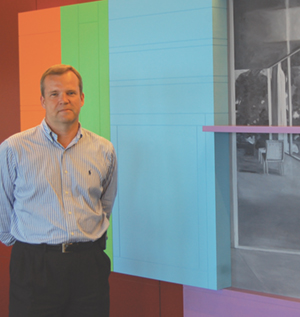At the end of a corridor on the 53rd floor of the TD Bank Tower in Toronto, a video plays near the reception of McCarthy Tétrault LLP.

The camera circles slowly and silently around Auguste Rodin’s somber sculpted tribute to a famous 14th-century French defeat, the Burghers of Calais.
Suddenly, the picture cuts to a group of Korean motorcycle couriers recreating the slouched and sullen demeanour of the statue’s subjects.
This is the Burghers of Seoul by emerging Montreal artist Adad Hannah. It’s a piece that sums up McCarthys’ approach to its art collection, according to Brian Pel, chairman of the firm’s art committee.
“It’s nothing profound but it’s fun,” he says. “You don’t want to be overly serious about it. People get way too serious about art and art-speak. If the work is good, who cares who does it?”
A little further down the corridor, Pel picks up a small blue bird from its reflective glass base.
“When I installed this here, people called me up and said, ‘You can’t leave that there. It’s going to get stolen.’ But it hasn’t been and it won’t be,” Pel says of Blue Bird on Map by Euan Macdonald.
“If you come by here five or six times in a day, it’ll always be in a different position because people just pick it up. It’s interactive and it’s fun.”
The main corridor on the 53rd floor and its meeting rooms are packed with paintings and photographs. In fact, the only blank spaces on the walls have small notices indicating that a piece is out on loan to an exhibition.
The Art Gallery of Mississauga has temporarily commandeered several works, while some by the Canadian collective General Idea will travel all the way to Paris later this year.
“It’s part of the mandate to share the collection with others and make it accessible,” says Jeanne Parkin, an art consultant who curates the collection for McCarthys.
She has worked with the firm since it began collecting art around 25 years ago. Spurred on by generous corporate tax incentives for Canadian art, it has continued buying ever since.
But Pel says the early purchases encountered some resistance. “It was considered somewhat risqué and not in keeping with the character of the firm that many of the partners thought it had.”
But that sentiment has changed as the firm’s collection is now revered in corporate art circles as pre-eminent among Canadian companies. “I take directors around from the National Gallery and others,” says Parkin.
“Every museum that comes tells me they would give anything to have that collection. It’s not for investment; it’s not for decoration. One might think it’s to tart up the office, but not McCarthys. They’re looking for what is relevant today.”
As a former commercial photographer, Pel had a natural interest in the art committee at McCarthys, where anyone who’s keen is welcome. He feels the committee model has helped the firm cement its reputation by ensuring continuity.
“It’s different from some other corporations, where all of a sudden there’s an interest in art because the CEO has a passion for art,” he says. “Then they disappear, the collection no longer has that support, and it dies on the vine.”
Despite the firm’s reputation for art, Pel’s committee doesn’t always get its way. He looks longingly, for example, at a spot at one end of the corridor occupied by a bronze sculpture. “It’s not the one I wanted to go there,” he says.
Downstairs on the 50th floor in a less public space where lawyers have their offices, the words of the U.S. Department of Homeland Security’s threat levels - low, guarded, elevated, high, and severe - are written out in piercing neon lights.
The work was too controversial for a more prominent spot.
“It would have looked great at the end of that corridor, but someone decided it could offend our U.S. clients,” says Pel. “I think it’s quite a serious piece and it’s not making fun of anyone.”
On the lower floors, the collection shares space with the debris of a busy Bay Street firm. Boxes spill out of offices into the corridors, leaving guests to wonder whether they’re in fact another ironic unmarked piece of art, while another piece by Hannah, a photograph of a woman kissing a statue, faces the McCarthys tax library.
For his part, Pel says some employees are more enthusiastic than others about the collection. But he notes he really finds out how they feel when a work ends up moving. “We tend not to move the pieces around too much but when we do, we get a lot of comments.
People say, ‘Well, that’s my piece. I like it there outside my office.’ Then there’s others who say, ‘Please move that piece. I don’t want to look at it every day.’ We try to accommodate them as much as we can.”

 The camera circles slowly and silently around Auguste Rodin’s somber sculpted tribute to a famous 14th-century French defeat, the Burghers of Calais.
The camera circles slowly and silently around Auguste Rodin’s somber sculpted tribute to a famous 14th-century French defeat, the Burghers of Calais.